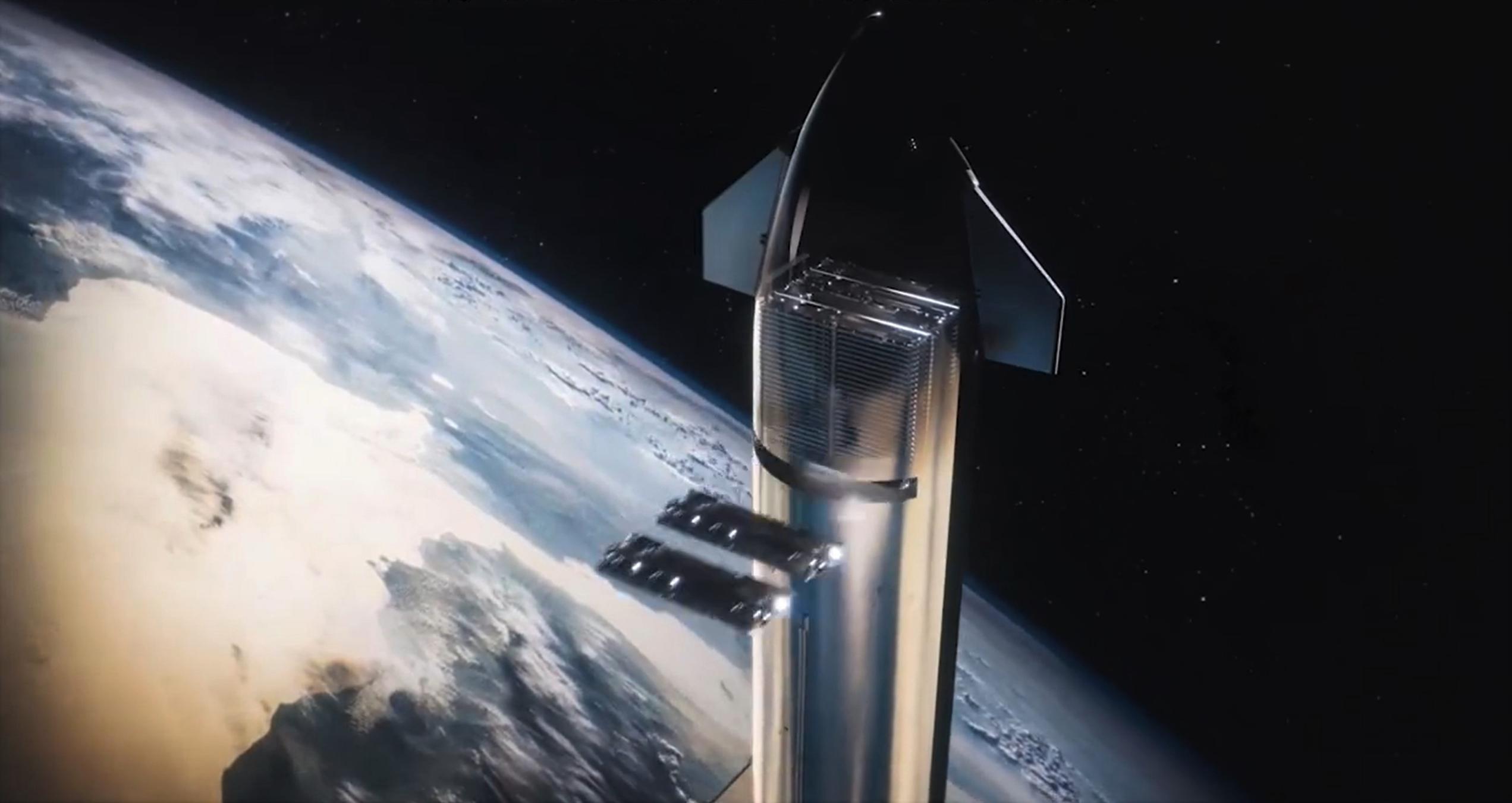
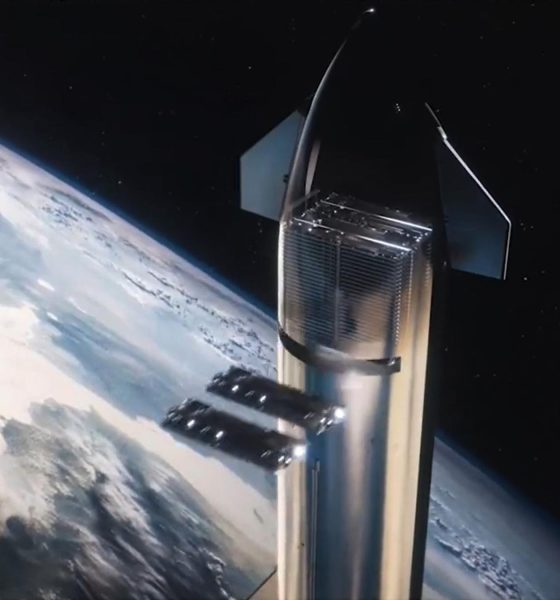
News
SpaceX’s first Starlink V2 satellites spotted at Starbase
On Monday, SpaceX was spotted loading some of the first Starlink V2 satellite prototypes into a custom mechanism designed to refill Starship’s magazine-like payload bay.
While it’s not the first time SpaceX has used the dispenser, the photos captured by photographer Kevin Randolph for the YouTube channel ‘What about it!?’ are the first to clearly show real prototypes of the next generation of Starlink satellites. According to CEO Elon Musk, those Starlink Gen2 or V2 satellites will be “at least 5 times better”, “an order of magnitude more capable,” and about four times heavier than current (V1.5) Starlink satellites.
The potential of the new satellite bus design paired with Starship’s massive fairing and lift capacity could dramatically improve the viability and cost-effectiveness of SpaceX’s Starlink constellation. First, though, the company needs to launch and qualify prototypes of the new satellite design and verify that all associated ground support equipment works as expected.
Due to the designs SpaceX has settled on for both Starlink V2.0 satellites and the Starship hardware that will deploy them in orbit, that ground support equipment and the general path each satellite will take from its arrival at the launch facilities to liftoff on a Starship are wildly different than anything done before. July 18th’s photos (and screenshots from a recent factory tour) confirm that the next-gen satellites are basically enlarged versions of their smaller predecessors, which are also narrow rectangles.
The new spacecraft have a very similar aspect ratio but are around seven meters long and three meters wide (23′ x 10′) instead of approximately 3m x 1.5m (10′ x 5′). They also appear to be about twice as thick and reportedly weigh ~1,250 kilograms to V1.5’s estimated 310 kilograms (~2,750 lb vs ~680 lb). As a result, the V2.0 bus will have about 7-10 times more usable volume than V1.0 and V1.5. It should be no surprise, then, that each next-gen satellite could offer almost magnitude more usable bandwidth.
Assuming that Starship launch costs are roughly the same as Falcon 9 and that Starship can only launch a similar 50-60 satellites at once, an almost 10x performance improvement from a satellite that only weighs five times as much relative to V1.5 would make Starlink V2.0 constellation deployment at least twice as cost-efficient to deploy even if Starship could only launch the same mass (~16 tons) as Falcon 9. In fact, a recent SpaceX render suggests that Starship will be able to carry 54 Starlink V2.0 satellites initially. As a result, even if Starship costs five times more to launch than Falcon 9 (~$75M), it will still be cheaper per unit of bandwidth launched. If Starship eventually reaches marginal launch costs as low as Falcon 9 (~$15M), the cost of Starlink launches (not including satellite cost) could plummet from about $15,000 per gigabit per second (Gbps) to around $1,500-2,500 per Gbps depending on individual satellite bandwidth.
The total cost of the network will be higher, of course, and dependent on more variables, but the combination of Starship and V2.0 satellites could eventually reduce the relative cost of Starlink launch operations by a factor of 5-10. If Starlink V2.0 satellites are actually cheaper to manufacture per unit of throughput than V1.5 satellites, which is not implausible once mass-production begins, those savings will deepen. If Starship can quickly mature and becomes fully and efficiently reusable, the equation could become even more favorable.
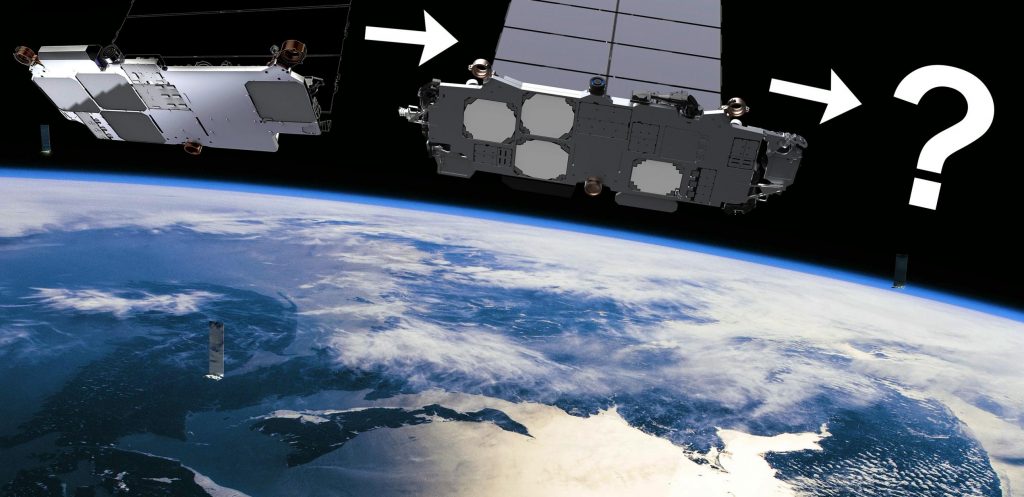
Still, loading Starship with satellites is going to be no minor feat and will add a significant amount of complexity and risk relative to the methods SpaceX currently uses for Falcon 9 Starlink launches. SpaceX’s initial Starship payload bay design is a roughly square enclosure that slots just above the ship’s uppermost tank dome and below its inward-curving nosecone. Per a render of the mechanism released last month, it measures about nine meters (30 ft) tall and eight meters (26 ft) wide, can store up to 54 Starlink V2.0 satellites, and dispenses pairs of satellites through a relatively tiny payload bay door that’s only wide enough for the task at hand.
Starship’s airframe is almost exclusively welded together. Once the nosecone and payload bay are installed on top of a ship, the only way to access the interior of the bay is through the dispenser door or an even smaller human-sized access port. SpaceX’s solution: build a mobile satellite storage box that will be lifted by crane (or launch tower arms) dozens to hundreds of feet off the ground and use the payload bay’s own dispenser mechanism in reverse to load satellites like bullets into a giant magazine. If that sounds simple, which it shouldn’t, it’s not.
It’s great, then, to see SpaceX apparently practicing that process with some of the first Starlink V2.0 prototypes. In photos captured on July 18th, workers were spotted loading several satellites into the only existing ‘loader’ inside one of Starbase’s three main factory tents. Each satellite was lifted using a load-spreader device that was presumably required to prevent the extremely long and thin satellites from bending too much in the middle during the lift. It’s unclear whether SpaceX is solely practicing the process or if it’s actually installing satellites well in advance for loading onto a Starship prototype.
Starship S24 is in the middle of preflight testing and has already been greeted by the satellite loader once before, possibly to load a prototype or mockup before ground testing began. Starship S25 appears to be at least a month or two away from completion, though its nose and payload bay section are much closer.

News
Tesla FSD (Supervised) stuns Germany’s biggest car magazine
FSD Supervised recognized construction zones, braked early for pedestrians, and yielded politely on narrow streets.
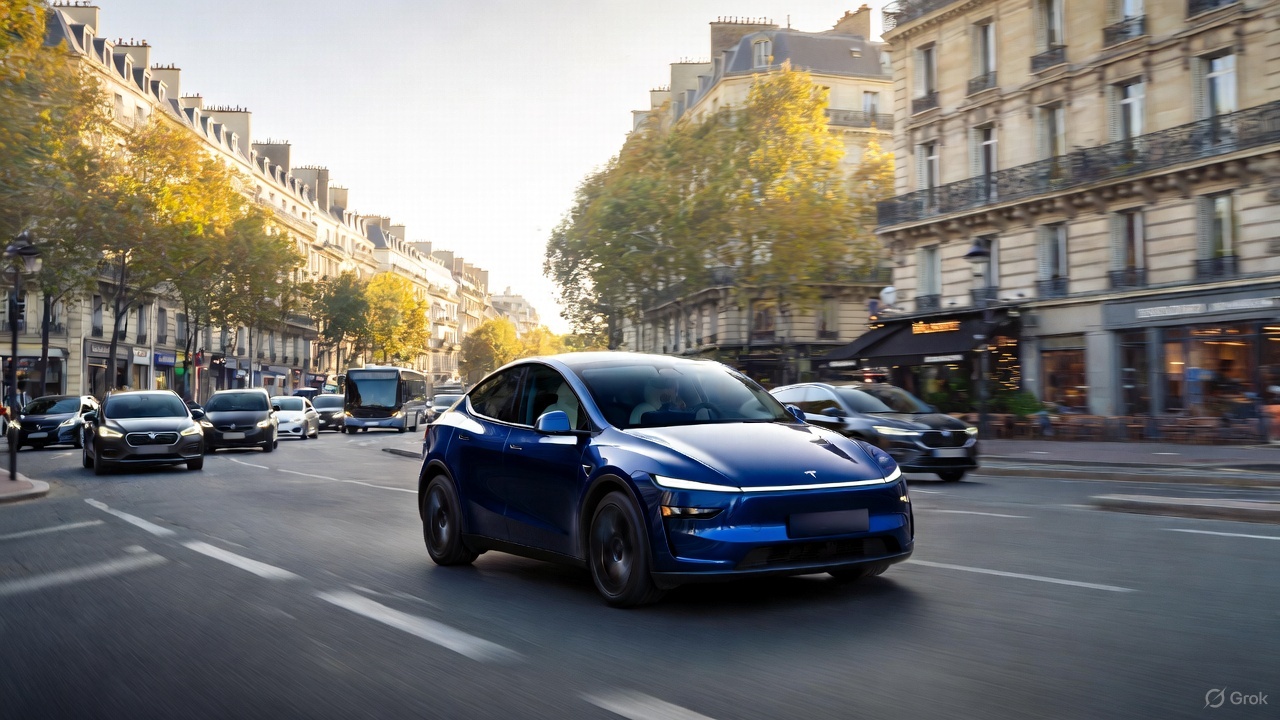
Tesla’s upcoming FSD Supervised system, set for a European debut pending regulatory approval, is showing notably refined behavior in real-world testing, including construction zones, pedestrian detection, and lane changes, as per a recent demonstration ride in Berlin.
While the system still required driver oversight, its smooth braking, steering, and decision-making illustrated how far Tesla’s driver-assistance technology has advanced ahead of a potential 2026 rollout.
FSD’s maturity in dense city driving
During the Berlin test ride with Auto Bild, Germany’s largest automotive publication, a Tesla Model 3 running FSD handled complex traffic with minimal intervention, autonomously managing braking, acceleration, steering, and overtaking up to 140 km/h. It recognized construction zones, braked early for pedestrians, and yielded politely on narrow streets.
Only one manual override was required when the system misread a converted one-way route, an example, Tesla stated, of the continuous learning baked into its vision-based architecture.
Robin Hornig of Auto Bild summed up his experience with FSD Supervised with a glowing review of the system. As per the reporter, FSD Supervised already exceeds humans with its all-around vision. “Tesla FSD Supervised sees more than I do. It doesn’t get distracted and never gets tired. I like to think I’m a good driver, but I can’t match this system’s all-around vision. It’s at its best when both work together: my experience and the Tesla’s constant attention,” the journalist wrote.
Tesla FSD in Europe
FSD Supervised is still a driver-assistance system rather than autonomous driving. Still, Auto Bild noted that Tesla’s 360-degree camera suite, constant monitoring, and high computing power mark a sizable leap from earlier iterations. Already active in the U.S., China, and several other regions, the system is currently navigating Europe’s approval pipeline. Tesla has applied for an exemption in the Netherlands, aiming to launch the feature through a free software update as early as February 2026.
What Tesla demonstrated in Berlin mirrors capabilities already common in China and the U.S., where rival automakers have rolled out hands-free or city-navigation systems. Europe, however, remains behind due to a stricter certification environment, though Tesla is currently hard at work pushing for FSD Supervised’s approval in several countries in the region.
News
Tesla reliability rankings skyrocket significantly in latest assessment
“They definitely have their struggles, but by continuing to refine and not make huge changes in their models, they’re able to make more reliable vehicles, and they’ve moved up our rankings.”
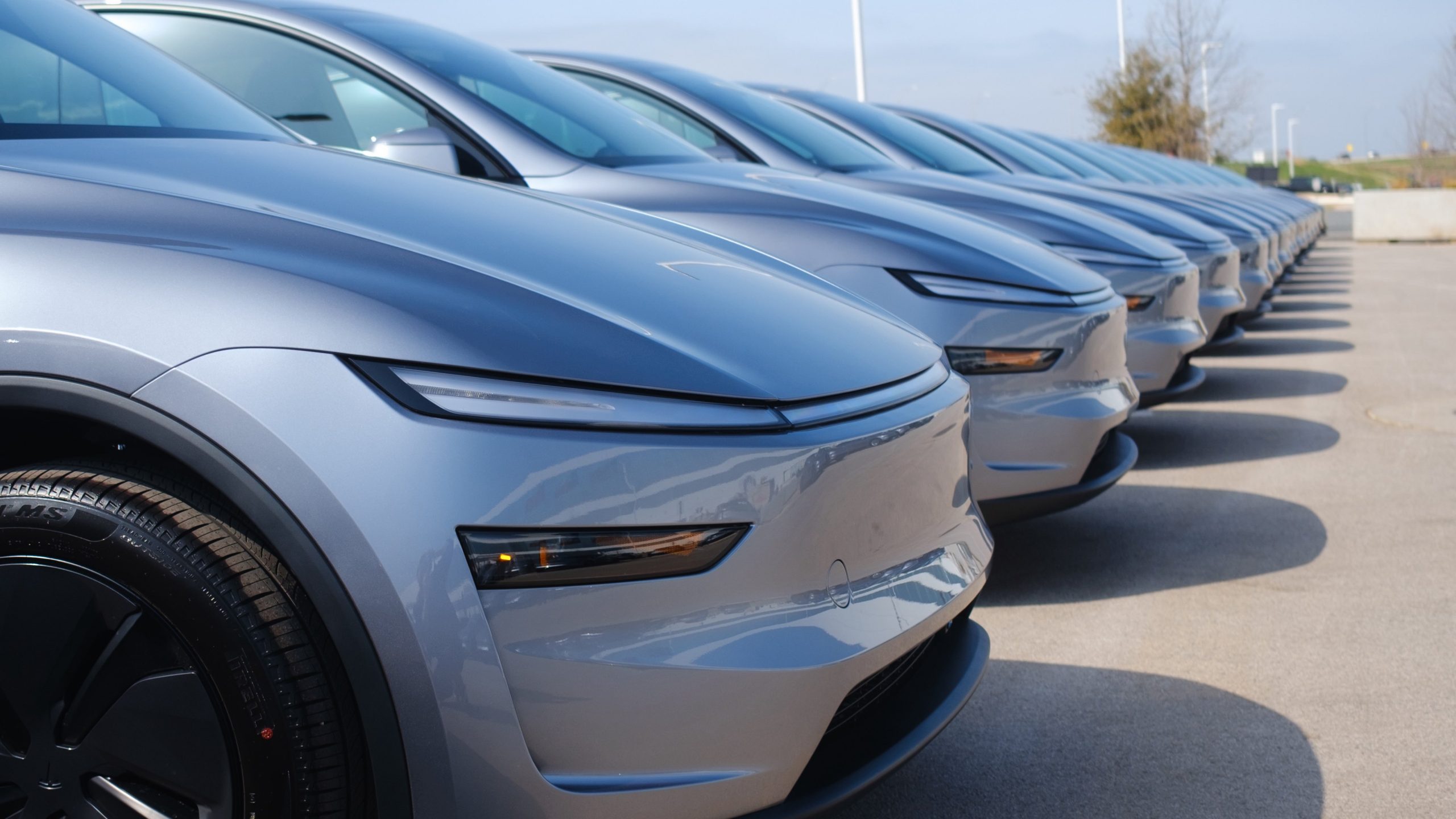
Tesla ranked in the Top 10 of the most reliable car companies for 2026, as Consumer Reports’ latest index showed significant jumps from the past two years.
In 2022, Tesla ranked 27th out of 28 brands. Last year, it came in 17th.
🚨🚨 Tesla entered the Top 10 in Consumer Reports’ list of reliable carmakers for the first time
In the past two years, Tesla has ranked 17th in 2024 and 27th out of 28 brands in 2022.
Subaru, BMW, Porsche, Honda, and Toyota were the Top 5 OEMs in the rankings. pic.twitter.com/z216bccVoH
— TESLARATI (@Teslarati) December 4, 2025
However, 2026’s rankings were different. CR‘s rankings officially included Tesla in the Top 10, its best performance to date.
Finishing tenth, the full Top 10 is:
- Subaru
- BMW
- Porsche
- Honda
- Toyota
- Lexus
- Lincoln
- Hyundai
- Acura
- Tesla
Tesla has had steady improvements in its build quality, and its recent refinements of the Model 3 and Model Y have not gone unnoticed.
The publication’s Senior Director of Auto Testing, Jake Fisher, said about Tesla that the company’s ability to work through the rough patches has resulted in better performance (via CNBC):
“They definitely have their struggles, but by continuing to refine and not make huge changes in their models, they’re able to make more reliable vehicles, and they’ve moved up our rankings.”
He continued to say that Tesla’s vehicles have become more reliable over time, and its decision to avoid making any significant changes to its bread-and-butter vehicles has benefited its performance in these rankings.
Legacy automakers tend to go overboard with changes, sometimes keeping a model name but recognizing a change in its “generation.” This leads to constant growing pains, as the changes in design require intense adjustments on the production side of things.
Instead, Tesla’s changes mostly come from a software standpoint, which are delivered through Over-the-Air updates, which improve the vehicle’s functionality or add new features.
Only one Tesla vehicle scored below average in Consumer Reports’ rankings for 2026 was the Cybertruck. Fisher’s belief that Tesla improves its other models over time might prove to be true with Cybertruck in a few years.
He continued:
“They’re definitely improving by keeping with things and refining, but if you look at their 5- to 10-year-old models that are out there, when it comes to reliability, they’re dead last of all the brands. They’re able to improve the reliability if they don’t make major changes.”
Regarding Subaru’s gold medal placing on the podium, Fisher said:
“While Subaru models provide good performance and comfort, they also excel in areas that may not be immediately apparent during a test drive.”
Other notable brands to improve are Rivian, which bumped itself slightly from 31 to 26. Chevrolet finished 24th, GMC ended up 29th, and Ford saw itself in 18th.
Elon Musk
Tesla Full Self-Driving v14.2.1 texting and driving: we tested it
We decided to test it, and our main objective was to try to determine a more definitive label for when it would allow you to grab your phone and look at it without any nudge from the in-car driver monitoring system.

On Thursday, Tesla CEO Elon Musk said that Full Self-Driving v14.2.1 would enable texting and driving “depending on [the] context of surrounding traffic.”
Tesla CEO Elon Musk announces major update with texting and driving on FSD
We decided to test it, and our main objective was to try to determine a more definitive label for when it would allow you to grab your phone and look at it without any nudge from the in-car driver monitoring system.
I’d also like to add that, while Tesla had said back in early November that it hoped to allow this capability within one to two months, I still would not recommend you do it. Even if Tesla or Musk says it will allow you to do so, you should take into account the fact that many laws do not allow you to look at your phone. Be sure to refer to your local regulations surrounding texting and driving, and stay attentive to the road and its surroundings.
The Process
Based on Musk’s post on X, which said the ability to text and drive would be totally dependent on the “context of surrounding traffic,” I decided to try and find three levels of congestion: low, medium, and high.
I also tried as best as I could to always glance up at the road, a natural reaction, but I spent most of my time, during the spans of when it was in my hand, looking at my phone screen. I limited my time looking at the phone screen to a few seconds, five to seven at most. On local roads, I didn’t go over five seconds; once I got to the highway, I ensured the vehicle had no other cars directly in front of me.
Also, at any time I saw a pedestrian, I put my phone down and was fully attentive to the road. I also made sure there were no law enforcement officers around; I am still very aware of the law, which is why I would never do this myself if I were not testing it.
I also limited the testing to no more than one minute per attempt.
I am fully aware that this test might ruffle some feathers. I’m not one to text and drive, and I tried to keep this test as abbreviated as possible while still getting some insight on how often it would require me to look at the road once again.
The Results
Low Congestion Area
I picked a local road close to where I live at a time when I knew there would be very little traffic. I grabbed my phone and looked at it for no more than five seconds before I would glance up at the road to ensure everything was okay:
In full: the Low Congestion Area pic.twitter.com/6DqlBnekPn
— TESLARATI (@Teslarati) December 4, 2025
Looking up at the road was still regular in frequency; I would glance up at the road after hitting that five-second threshold. Then I would look back down.
I had no nudges during this portion of the test. Traffic was far from even a light volume, and other vehicles around were very infrequently seen.
Medium Congestion Area
This area had significantly more traffic and included a stop at a traffic light. I still kept the consecutive time of looking at my phone to about five seconds.
I would quickly glance at the road to ensure everything was okay, then look back down at my phone, spending enough time looking at a post on Instagram, X, or Facebook to determine what it was about, before then peeking at the road again.
There was once again no alert to look at the road, and I started to question whether I was even looking at my phone long enough to get an alert:
In full: the Medium Congestion Area pic.twitter.com/gnhIfBVe6Q
— TESLARATI (@Teslarati) December 4, 2025
Based on past versions of Full Self-Driving, especially dating back to v13, even looking out the window for too long would get me a nudge, and it was about the same amount of time, sometimes more, sometimes less, I would look out of a window to look at a house or a view.
High Congestion Area
I decided to use the highway as a High Congestion Area, and it finally gave me an alert to look at the road.
As strange as it is, I felt more comfortable looking down at my phone for a longer amount of time on the highway, especially considering there is a lower chance of a sudden stop or a dangerous maneuver by another car, especially as I was traveling just 5 MPH over in the left lane.
This is where I finally got an alert from the driver monitoring system, and I immediately put my phone down and returned to looking at the road:
In full: the High Congestion Area pic.twitter.com/K9rIn4ROvm
— TESLARATI (@Teslarati) December 4, 2025
Once I was able to trigger an alert, I considered the testing over with. I think in the future I’d like to try this again with someone else in the car to keep their eyes on the road, but I’m more than aware that we can’t always have company while driving.
My True Thoughts
Although this is apparently enabled based on what was said, I still do not feel totally comfortable with it. I would not ever consider shooting a text or responding to messages because Full Self-Driving is enabled, and there are two reasons for that.
The first is the fact that if an accident were to happen, it would be my fault. Although it would be my fault, people would take it as Tesla’s fault, just based on what media headlines usually are with accidents involving these cars.
Secondly, I am still well aware that it’s against the law to use your phone while driving. In Pennsylvania, we have the Paul Miller Law, which prohibits people from even holding their phones, even at stop lights.
I’d feel much more comfortable using my phone if liability were taken off of me in case of an accident. I trust FSD, but I am still erring on the side of caution, especially considering Tesla’s website still indicates vehicle operators have to remain attentive while using either FSD or Autopilot.
Check out our full test below:








